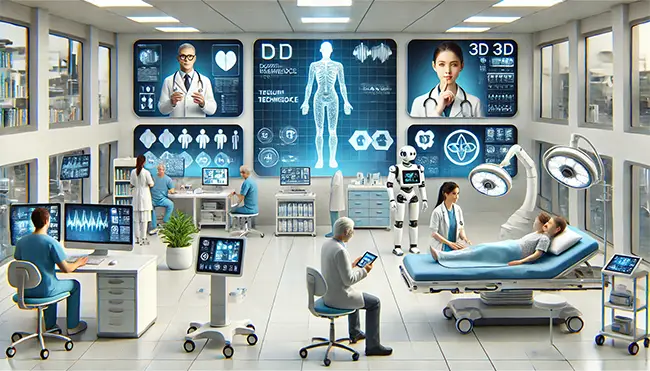Future Hospitals
July 8, 2024

Hospitals have always been the backbone of healthcare, providing essential services and care to millions of people worldwide. As technology advances, the future of hospitals promises to be even more remarkable, transforming the way we receive medical care and interact with healthcare systems.
Telemedicine
One of the most significant changes in healthcare is the rise of telemedicine. This technology allows patients to consult with doctors remotely, using video calls and other digital communication tools. Telemedicine can make healthcare more accessible, especially for people living in remote or underserved areas. It also reduces the need for physical visits to hospitals, which can save time and reduce the strain on healthcare facilities.
For example, imagine a patient with a chronic condition like diabetes. Instead of traveling to the hospital for regular check-ups, they can have virtual appointments with their doctor. The doctor can monitor their condition using data from wearable devices and provide advice and prescriptions as needed. This approach not only improves convenience for patients but also allows doctors to manage more patients effectively.
Robotics
Robots are becoming increasingly common in hospitals, performing tasks ranging from surgery to patient care. Surgical robots, for instance, allow doctors to perform minimally invasive procedures with greater precision. These robots can make tiny incisions, reducing recovery times and the risk of complications.
In addition to surgical robots, hospitals are also using robots for tasks like disinfecting rooms, delivering supplies, and even assisting with patient mobility. These robots can work around the clock, ensuring that hospitals operate efficiently and maintain high standards of cleanliness and safety.
Artificial Intelligence
Artificial intelligence (AI) is another game-changer in the future of hospitals. AI systems can analyze vast amounts of medical data quickly and accurately, helping doctors diagnose conditions and develop personalized treatment plans. For instance, AI algorithms can analyze medical images, such as X-rays and MRIs, to detect anomalies that might be missed by the human eye.
AI can also assist in predicting patient outcomes and identifying potential health risks. By analyzing patient data, AI can help doctors anticipate complications and take preventive measures. This proactive approach can lead to better patient outcomes and more efficient use of healthcare resources.
3D Printing
3D printing is revolutionizing the way hospitals approach patient care. This technology allows for the creation of customized medical devices and implants, tailored to the specific needs of individual patients. For example, doctors can use 3D printing to create prosthetic limbs that fit perfectly, improving comfort and functionality for patients.
3D printing can also be used to produce surgical models, allowing doctors to plan and practice complex procedures before performing them on patients. This level of preparation can enhance surgical precision and reduce the risk of complications.
Wearable Technology
Wearable technology, such as smartwatches and fitness trackers, is becoming an integral part of healthcare. These devices can monitor vital signs like heart rate, blood pressure, and oxygen levels, providing real-time data to doctors and patients. This continuous monitoring can help detect health issues early and allow for timely intervention.
For example, a patient with a heart condition can wear a smartwatch that monitors their heart rate and sends alerts if any irregularities are detected. This information can be shared with their doctor, who can then adjust their treatment plan as needed. Wearable technology empowers patients to take an active role in managing their health and allows doctors to provide more personalized care.
Inclusivity and Access
The technological advancements in hospitals have the potential to make healthcare more inclusive and accessible. Telemedicine and wearable technology can bridge the gap for people in remote areas, ensuring they receive the care they need. AI and robotics can enhance the efficiency of hospitals, allowing them to serve more patients without compromising on the quality of care.
Moreover, these technologies can reduce healthcare costs by streamlining processes and minimizing the need for expensive interventions. This cost-effectiveness can make healthcare more affordable for everyone, ensuring that no one is left behind.
The future of hospitals is bright, with technology playing a pivotal role in transforming healthcare. From telemedicine and robotics to AI and 3D printing, these advancements promise to improve patient outcomes, enhance efficiency, and make healthcare more inclusive. As we continue to embrace these innovations, hospitals will be better equipped to meet the needs of our evolving society, ensuring that everyone has access to high-quality medical care.

